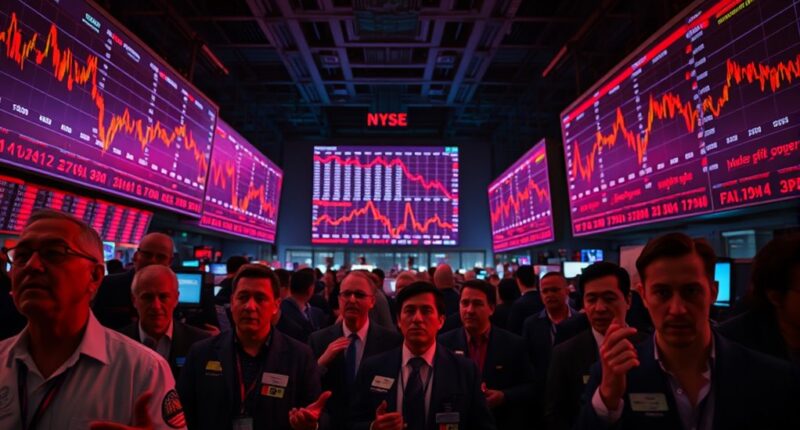Governance tokens are dumping mainly because of sudden price drops, limited utility, and market manipulation by large players. When holders see no real benefits beyond voting, they tend to sell quickly, which worsens price declines. Market manipulations by whales can trigger panic selling, fueling volatility and distrust. To fix this, you can improve token utility, promote transparency, and prevent unfair trading. If you want to learn more about effective strategies to stabilize governance tokens, keep exploring this topic.
Key Takeaways
- Limited utility and practical use reduce holder interest, leading to increased dumping during downturns.
- Market manipulation by large holders (“whales”) triggers panic selling and cascades price declines.
- Lack of long-term incentives and utility diminishes investor confidence and encourages quick profit-taking.
- Enhancing token utility through platform features and rewards can promote longer-term holding.
- Transparent trading practices and community engagement help build trust, reducing speculation-driven dumps.

Governance tokens are essential tools in decentralized ecosystems, giving holders voting power over project decisions. However, their value can plummet suddenly, leading to widespread dumping. One major reason is the fluctuating perception of token utility. When holders see little practical use for their tokens beyond voting, they may lose interest or seek quick profits, especially if they believe the project’s future is uncertain. If a governance token doesn’t offer tangible benefits—like access to features, dividends, or other incentives—its appeal diminishes. Without strong utility, people might hold tokens only temporarily, ready to sell at the first sign of profit. This short-term mindset accelerates dumping, especially during market downturns or when project news is negative. Additionally, the high volatility of these tokens can further discourage long-term holding strategies, making the ecosystem more susceptible to rapid price swings. Market manipulation also plays a significant role in these declines. Large holders, often called whales, can influence token prices by executing coordinated buy or sell actions. These manipulations create false signals, causing panic or euphoria among smaller investors. When whales dump tokens en masse, it triggers a cascade effect, pushing prices further down. The fear of being left holding devalued tokens prompts more rapid sell-offs, amplifying the downward spiral. This manipulation erodes trust in the token’s stability and deters long-term investors, making the ecosystem more volatile and susceptible to pump-and-dump schemes. To address these issues, project teams and communities need to focus on enhancing token utility. This means integrating governance tokens into the platform’s ecosystem so they serve more than just voting rights. For example, allowing token holders to access exclusive features, earn rewards, or participate in profit-sharing can make holding more attractive. When utility is clear and valuable, holders are more likely to keep their tokens long-term, reducing impulsive dumping. Simultaneously, transparency around token distribution and trading activity is essential to combat market manipulation. Implementing measures like anti-whale policies, monitoring large transactions, and promoting fair trading practices can help stabilize prices. Encouraging community engagement and education about the project’s goals also builds trust and discourages speculative behavior driven by manipulation. Ultimately, fixing the dumping problem requires a dual approach: making tokens more useful and protecting the market from manipulation. When holders see real value and trust the ecosystem’s integrity, they’re less likely to panic sell. This stability benefits everyone, fostering a healthier, more resilient decentralized environment.
Frequently Asked Questions
How Do Governance Tokens Influence Project Decision-Making?
Governance tokens directly influence project decision-making by granting you voting power based on your token holdings. The distribution of tokens determines who holds sway in proposals and upgrades. If tokens are concentrated, a few hold significant influence, potentially skewing decisions. You can help guarantee fair voting by supporting more equitable token distribution, encouraging community participation, and preventing power centralization, so everyone has a say in shaping the project’s future.
What Are Common Signs of Governance Token Market Manipulation?
You should watch for signs of market manipulation in governance tokens, like sudden swings in market sentiment or unusual whale activity. If large holders start rapidly buying or selling, it can distort prices and create false signals. Keep an eye on trading volumes and price movements, as these can indicate coordinated efforts to influence the market. Recognizing these signs helps you stay alert and protect your investments from manipulation tactics.
How Can Projects Encourage Long-Term Holding of Governance Tokens?
You can encourage long-term holding of governance tokens by focusing on fair token distribution, ensuring community members feel valued and motivated to stay invested. Boost community engagement through regular updates, transparent decision-making, and rewards for participation. When people see their influence and benefits grow over time, they’re more likely to hold onto their tokens, fostering stability and trust in the project’s future.
Are There Legal Regulations Impacting Governance Token Trading?
You should be aware that legal regulations impact governance token trading considerably. Regulatory frameworks aim to ensure legal compliance, which means adhering to securities laws and anti-money laundering rules. These regulations can restrict or modify how you trade tokens, making it essential to stay informed about local laws. By understanding these legal requirements, you can avoid penalties and ensure your trading activities remain compliant with evolving governance token regulations.
What Role Do Lock-Up Periods Play in Preventing Dumps?
Lock-up periods, involving token vesting and investor lock-ins, help prevent dumps by restricting when holders can sell their tokens. When you implement these measures, you guarantee early investors can’t sell all their tokens immediately, which stabilizes the market. This encourages long-term commitment, reducing drastic price drops. By enforcing lock-up periods, you create a more sustainable token ecosystem, fostering trust among participants and preventing sudden, large-scale sell-offs.
Conclusion
To fix governance token dumping, you need to understand its causes and take proactive steps. Consider implementing staking rewards to incentivize holding, improving project transparency to build trust, and designing tokenomics that align long-term interests. Engage your community regularly, and avoid rushed token releases. By focusing on sustainable strategies and fostering strong engagement, you can stabilize governance tokens and guarantee they genuinely support your project’s growth and decentralization.









